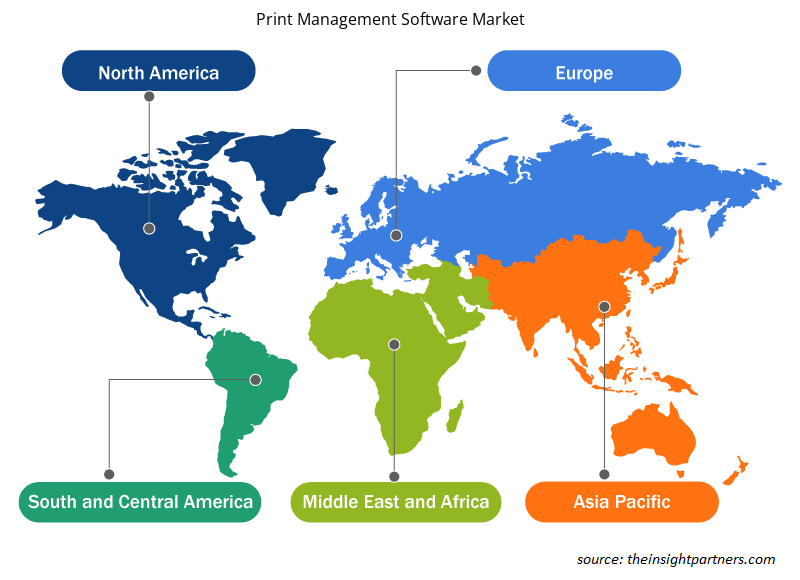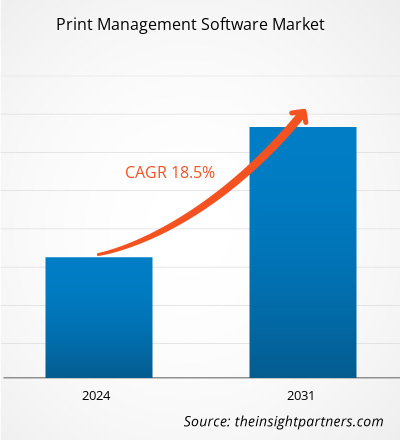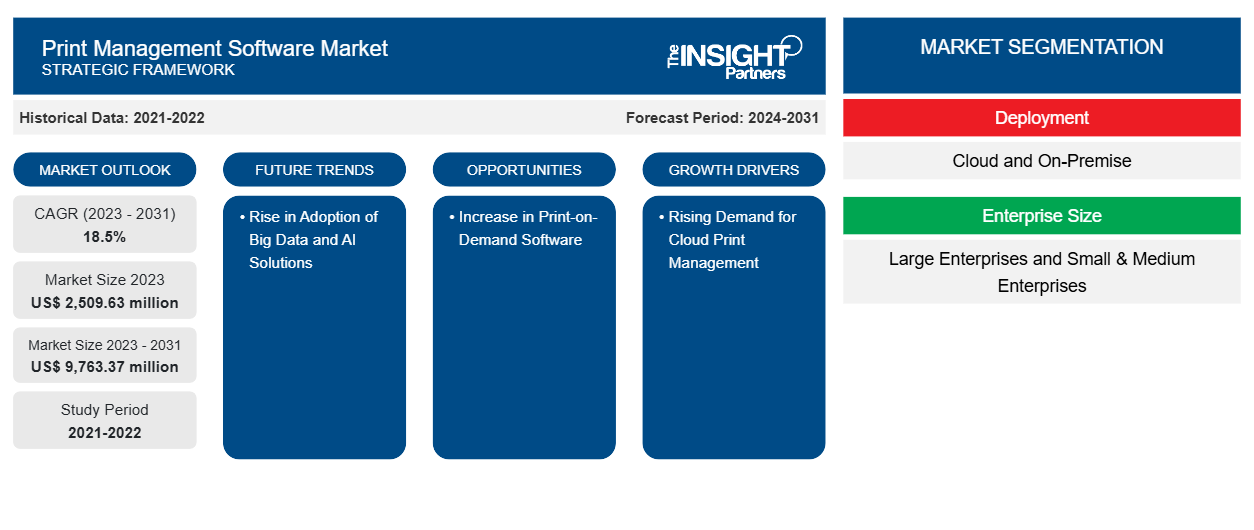من المتوقع أن يصل حجم سوق برامج إدارة الطباعة إلى 9,763.37 مليون دولار أمريكي بحلول عام 2031 من 2,509.63 مليون دولار أمريكي في عام 2023. ومن المتوقع أن يسجل السوق معدل نمو سنوي مركب بنسبة 18.5٪ خلال الفترة 2023-2031. ومن المرجح أن يظل الارتفاع في اعتماد حلول البيانات الضخمة والذكاء الاصطناعي اتجاهًا رئيسيًا في السوق.
تحليل سوق برامج إدارة الطباعة
تشمل الجهات المعنية الرئيسية في سوق برامج إدارة الطباعة موفري البرامج ومُدمجي الأنظمة والمستخدمين النهائيين. يطور موفرو برامج إدارة الطباعة ويبيعون البرامج للمؤسسات لمساعدتها في إدارة البنية الأساسية للطباعة. تشمل بعض البائعين الرائدين HP وXerox وCanon وRicoh وPaperCut وY Soft. يُعد مُدمجو الأنظمة لاعبين أساسيين في النظام البيئي لسوق برامج إدارة الطباعة. إنهم يعملون كجسر بين المكونات المختلفة في النظام البيئي لضمان بيئة طباعة سلسة ومُحسَّنة للشركات. كما يلعبون دورًا حاسمًا في دمج الحلول المتنوعة. المستخدمون النهائيون هم المؤسسات التي تستخدم برامج إدارة الطباعة لإدارة البنية الأساسية للطباعة. يمكن أن يكون المستخدمون النهائيون من أي حجم، من الشركات الصغيرة إلى الشركات الكبيرة، على سبيل المثال، BFSI وIT وTelecom وHealthcare وTجارة التجزئة.
نظرة عامة على سوق برامج إدارة الطباعة
يهدف برنامج إدارة الطباعة إلى إدارة أجهزة وعمليات الطباعة بفعالية وكفاءة . مع تثبيت البرنامج، تصبح عملية مراقبة أسطول الطابعات بالكامل وصيانته والتحكم فيه من خلال واجهة تطبيق واحدة سهلة للغاية. كما يسهل وظائف التوزيع والطباعة والطباعة السريعة والطباعة الأوفست. ومن بين العوامل الأخرى التي من المتوقع أن تستمر في دعم نمو السوق عالميًا في السنوات القادمة الطلب المتزايد على البيانات في الوقت الفعلي على أسطول الطابعات والحاجة المتزايدة لإدارة عملية الطباعة المؤسسية وتحسينها من خلال برنامج إدارة الطباعة.
قم بتخصيص هذا التقرير ليناسب متطلباتك
ستحصل على تخصيص لأي تقرير - مجانًا - بما في ذلك أجزاء من هذا التقرير، أو تحليل على مستوى الدولة، وحزمة بيانات Excel، بالإضافة إلى الاستفادة من العروض والخصومات الرائعة للشركات الناشئة والجامعات
- احصل على أهم اتجاهات السوق الرئيسية لهذا التقرير.ستتضمن هذه العينة المجانية تحليلاً للبيانات، بدءًا من اتجاهات السوق وحتى التقديرات والتوقعات.
محركات وفرص سوق برامج إدارة الطباعة
الطلب المتزايد على إدارة الطباعة السحابية
نظرًا لأن برامج إدارة الطباعة تساعد في دمج ودعم بيئة السحابة في مكان العمل، فهناك طلب سريع على الطباعة السحابية بين المؤسسات التي لديها رفوف خوادم وبنية أساسية محلية. بالإضافة إلى ذلك، تراقب إدارة الطباعة السحابية بيئات الطباعة في السحابة وتتبعها وتديرها بدلاً من استخدام خادم الطباعة، وهو بنية أساسية محلية. يوفر العديد من اللاعبين الرئيسيين في السوق مجموعة واسعة من منتجات إدارة الطباعة للعملاء الذين يبحثون عن حلول طباعة سحابية خاصة وعامة. في يونيو 2022، أعلنت شركة Ricoh Canada Inc. عن إطلاق RICOH Print Management Cloud لتبسيط البنية الأساسية للطباعة، والقضاء على خوادم الطباعة، وتقليل العبء على تكنولوجيا المعلومات باستخدام حل SaaS الفعال من حيث التكلفة. وبالتالي، تبحث الشركات عن طباعة قوية وآمنة دون الحاجة إلى خوادم طباعة في الموقع.
زيادة في برامج الطباعة حسب الطلب
تساعد برامج الطباعة حسب الطلب في إدارة وتحسين آلات الطباعة والإجراءات الأخرى بدقة وكفاءة. كما يتوفر برنامج الطباعة حسب الطلب بشكل أساسي كبرنامج مستقل ووظائف مدمجة في مرافق الطباعة المُدارة. كما يساعد تتبع وإدارة والتحكم في أسطول الطابعات بالكامل من واجهة تطبيق واحدة الشركات على توفير المال في الطباعة. كما تسمح الماسحات الضوئية والطابعات المكتبية والناسخات المُدارة بالتحكم الموحد في برنامج إدارة الطباعة. ونتيجة لذلك، من المتوقع أن تخلق هذه العوامل فرص نمو مربحة للسوق في السنوات القادمة.
تقرير تحليل تجزئة سوق برامج إدارة الطباعة
إن القطاعات الرئيسية التي ساهمت في اشتقاق تحليل سوق برامج إدارة الطباعة هي النشر وحجم المؤسسة والصناعة.
- بناءً على النشر، ينقسم سوق برامج إدارة الطباعة إلى السحابة والمحلية. احتل قطاع السحابة حصة سوقية أكبر في عام 2023.
- بحسب حجم المؤسسة، يتم تقسيم السوق إلى شركات كبيرة وشركات صغيرة ومتوسطة الحجم. وقد استحوذت شريحة الشركات الكبيرة على حصة سوقية أكبر في عام 2023.
- حسب القطاع الرأسي، يتم تقسيم السوق إلى BFSI، والرعاية الصحية، وتكنولوجيا المعلومات والاتصالات، وتجارة التجزئة، وغيرها.
تحليل حصة سوق برامج إدارة الطباعة حسب المنطقة الجغرافية
ينقسم النطاق الجغرافي لتقرير سوق برامج إدارة الطباعة بشكل أساسي إلى خمس مناطق: أمريكا الشمالية، ومنطقة آسيا والمحيط الهادئ، وأوروبا، والشرق الأوسط وأفريقيا، وأمريكا الجنوبية والوسطى.
من المتوقع أن يشهد السوق في منطقة آسيا والمحيط الهادئ نموًا ملحوظًا خلال الفترة المتوقعة بسبب العدد المتزايد من مزودي برامج إدارة الطباعة والتركيز المتزايد على خفض تكاليف الطباعة.
رؤى إقليمية حول سوق برامج إدارة الطباعة
لقد قام المحللون في Insight Partners بشرح الاتجاهات والعوامل الإقليمية المؤثرة على سوق برامج إدارة الطباعة طوال فترة التوقعات بشكل شامل. يناقش هذا القسم أيضًا قطاعات سوق برامج إدارة الطباعة والجغرافيا في جميع أنحاء أمريكا الشمالية وأوروبا ومنطقة آسيا والمحيط الهادئ والشرق الأوسط وأفريقيا وأمريكا الجنوبية والوسطى.

- احصل على البيانات الإقليمية المحددة لسوق برامج إدارة الطباعة
نطاق تقرير سوق برامج إدارة الطباعة
| سمة التقرير | تفاصيل |
|---|---|
| حجم السوق في عام 2023 | 2,509.63 مليون دولار أمريكي |
| حجم السوق بحلول عام 2031 | 9,763.37 مليون دولار أمريكي |
| معدل النمو السنوي المركب العالمي (2023 - 2031) | 18.5% |
| البيانات التاريخية | 2021-2022 |
| فترة التنبؤ | 2024-2031 |
| القطاعات المغطاة | حسب النشر
|
| المناطق والدول المغطاة | أمريكا الشمالية
|
| قادة السوق وملفات تعريف الشركات الرئيسية |
|
كثافة اللاعبين في السوق: فهم تأثيرها على ديناميكيات الأعمال
يشهد سوق برامج إدارة الطباعة نموًا سريعًا، مدفوعًا بالطلب المتزايد من المستخدم النهائي بسبب عوامل مثل تفضيلات المستهلكين المتطورة والتقدم التكنولوجي والوعي المتزايد بفوائد المنتج. ومع ارتفاع الطلب، تعمل الشركات على توسيع عروضها والابتكار لتلبية احتياجات المستهلكين والاستفادة من الاتجاهات الناشئة، مما يؤدي إلى زيادة نمو السوق.
تشير كثافة اللاعبين في السوق إلى توزيع الشركات أو المؤسسات العاملة في سوق أو صناعة معينة. وهي تشير إلى عدد المنافسين (اللاعبين في السوق) الموجودين في مساحة سوق معينة نسبة إلى حجمها أو قيمتها السوقية الإجمالية.
الشركات الرئيسية العاملة في سوق برمجيات إدارة الطباعة هي:
- تكنولوجيا AND
- شركة.
- شركة كانون
- شركة إي بايبر المحدودة
- شركة تنجستن للأتمتة
- برينتر لوجيك
إخلاء المسؤولية : الشركات المذكورة أعلاه ليست مرتبة بأي ترتيب معين.

- احصل على نظرة عامة على أهم اللاعبين الرئيسيين في سوق برامج إدارة الطباعة
أخبار سوق برامج إدارة الطباعة والتطورات الأخيرة
يتم تقييم سوق برامج إدارة الطباعة من خلال جمع البيانات النوعية والكمية بعد البحث الأولي والثانوي، والذي يتضمن منشورات الشركات المهمة وبيانات الجمعيات وقواعد البيانات. فيما يلي بعض التطورات في سوق برامج إدارة الطباعة:
- أعلنت شركة PaperCut أن شركة Google قامت بتوحيد معايير PaperCut MF لتعزيز البنية التحتية للطباعة الداخلية. يأتي هذا الإعلان بعد زوال خدمة Google Cloud Print. كانت هذه الخدمة تتيح للمستخدمين الداخليين والخارجيين الطباعة من أي تطبيق يدعم الطباعة السحابية، على أي جهاز في الشبكة السحابية إلى أي طابعة، مع إمكانية الاتصال بخدمات الطباعة السحابية. (المصدر: PaperCut، بيان صحفي، يوليو 2022)
- أطلقت شركة ThinPrint، وهي واحدة من الشركات الرائدة في مجال توفير حلول إدارة الطباعة، نهجًا جديدًا للطباعة عالية التوافر. توفر خدمة ThinPrint LPD طباعة عالية التوافر، بما في ذلك موازنة التحميل من أنظمة ERP وEMR وCRM. وبالتالي توفر ThinPrint أداة مهمة لمنع الانقطاعات الحرجة للأعمال. (المصدر: ThinPrint، بيان صحفي، ديسمبر 2023)
تقرير سوق برامج إدارة الطباعة والتغطية والنتائج المتوقعة
يوفر تقرير "حجم سوق برامج إدارة الطباعة والتوقعات (2021-2031)" تحليلاً مفصلاً للسوق يغطي المجالات التالية:
- حجم سوق برامج إدارة الطباعة وتوقعاته على المستويات العالمية والإقليمية والوطنية لجميع قطاعات السوق الرئيسية التي يغطيها النطاق
- اتجاهات سوق برامج إدارة الطباعة بالإضافة إلى ديناميكيات السوق مثل المحركات والقيود والفرص الرئيسية
- تحليل مفصل لقوى PEST/Porter الخمس وSWOT
- تحليل سوق برامج إدارة الطباعة الذي يغطي اتجاهات السوق الرئيسية والإطار العالمي والإقليمي واللاعبين الرئيسيين واللوائح والتطورات الأخيرة في السوق
- تحليل المشهد الصناعي والمنافسة الذي يغطي تركيز السوق، وتحليل خريطة الحرارة، واللاعبين البارزين، والتطورات الأخيرة في سوق برامج إدارة الطباعة
- ملفات تعريف الشركة التفصيلية
- التحليل التاريخي (سنتان)، سنة الأساس، التوقعات (7 سنوات) مع معدل النمو السنوي المركب
- تحليل PEST و SWOT
- حجم السوق والقيمة / الحجم - عالمي، إقليمي، بلد
- الصناعة والمنافسة
- مجموعة بيانات إكسل
التقارير الحديثة
تقارير ذات صلة
شهادات العملاء
سبب الشراء
- اتخاذ قرارات مدروسة
- فهم ديناميكيات السوق
- تحليل المنافسة
- رؤى العملاء
- توقعات السوق
- تخفيف المخاطر
- التخطيط الاستراتيجي
- مبررات الاستثمار
- تحديد الأسواق الناشئة
- تحسين استراتيجيات التسويق
- تعزيز الكفاءة التشغيلية
- مواكبة التوجهات التنظيمية





















 احصل على عينة مجانية ل - سوق برامج إدارة الطباعة
احصل على عينة مجانية ل - سوق برامج إدارة الطباعة